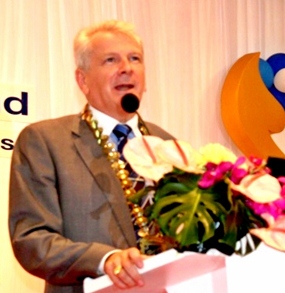Thailand’s tourism industry is enjoying record arrivals and I forecast that this good news will last for the foreseeable future subject to no natural calamities or political upheavals. Tourism revenue will climb to Bt2.0 trillion by next year. Political tensions with China’s neighbours will help Thailand. These territorial disputes lead to increased friction as China attempts to ‘stretch’ borders, which ultimately impact visitor choice… often in Thailand’s favour.
Thailand earned Bt984 billion in tourism revenue in 2012, from 22.35m foreign visitors. By region, tourists from Europe (5.45m) spent the highest portion, Bt 357 billion, according to the Department of Tourism.
 Andrew J Wood, National President, Skål International Thailand, www.skalthailand.org – Bangkok 19 July 2013.
Andrew J Wood, National President, Skål International Thailand, www.skalthailand.org – Bangkok 19 July 2013.
By country, China topped the chart, with Bt106 billion spent by 2.76m visitors. By next year Chinese tourists will account for 1 in 5 of all arrivals.
During my recent visit to Shanghai I was briefed by the tourism office that Thailand expects to welcome 6.09m Chinese visitors in 2014 and during a meeting in Bangkok with TAT Governor Suraphon Svetasreni I asked if this figure was a problem being such a high proportion of 28m arrivals next year?
Like me he was worried about too many eggs in one basket and whether it was sustainable both statistically and environmentally.
My personal observation after 22 years living in the kingdom is we need more infrastructure development… fast trains, efficient public transportation – buses, trams, bicycle lanes, subways.
In Bangkok we have to bite the bullet and introduce car-free areas and charge for bringing private cars into the CBD. Reducing traffic in this area of the metropolis is essential if we are ever to tackle chronic congestion.
It’s not just transport – tourist safety too – at every touch point it is vital; safe taxis; fire fighting equipment in hotels and guest houses; 3rd-party insurance for tourists and comprehensive hospital/medical care especially in up-country locations.
In addition, eliminate double pricing; provide efficient high speed free WiFi; increased policing to control scams by jet-ski operators, jewellery shops, taxis, tuk-tuks and mafia controlled businesses.
Malaysia has an excellent attitude to retirees including MM2H. Malaysia My Second Home is an initiative promoted and supported by the government to allow long stays with a multiple entry visa. The MM2H visa is initially for a period of 10 years and is renewable.
Thailand could learn from this programme for visitors who wish to retire or semi-retire. MM2H allows applicants many benefits currently not available in Thailand. As a result Thailand is losing out to this lucrative niche.
Tackling the shortage of tourism personnel has to be a national agenda item. The industry needs 10,000 hospitality graduates per year; however, our universities and colleges are pumping out less than half of that.
We have seen medical tourism grow from almost nothing to an industry that adds millions of visitors per annum. Thailand will attract 2.4m foreign patients this year.
According to a recent study by VISA, Thailand ranks number nine among the world’s top destinations for medical tourists. As long as Thailand continues to offer high-quality medical services at an affordable price, it is most likely that the title of ASEAN’s top medical tourism destination will go to the Land of Smiles.
Most tourists in 2012 were from ASEAN, 6.30m or 28% overall. To encourage multi-country trips across Southeast Asia, the Association of Southeast Asian Nations (ASEAN) is urging tour operators from the 10-member states, prior to the advent of AEC2015, to develop multi-country packages. TAT also launched it’s DISCO plan earlier this year.
This means travellers could choose multi-destination packages that allow them to experience a variety of cultures and landscape within ASEAN.
Today’s travellers are more sophisticated and are interested in unique experiences with immersion in local ways of life. I believe many visitors are looking for more than just sitting on a beach or shopping, although these two activities are vital to brand Thai.
ASEAN’s tourism strategy bodes well with the TAT’s goal of hitting 28 million tourist arrivals in 2014, but has the danger of ‘confusing’ consumers as it overlaps and in some cases duplicates the TAT’s marketing plan.
I see a rising trend among consumers that desire to seek a more authentic travel experience including volunteer tourism.
The advent of AEC on the 31st Dec 2015 also has serious ramifications for Thailand’s aviation industry. The ‘borderless’ community allows airlines the freedom to serve all capital cities in the region without flight restrictions. Thai aviation business has been upbeat since early this year, given that domestic and international passenger traffic at Suvarnabhumi Airport and Don Mueang Airport surged 17.5% to 28.51m during the first five months this year, against a record high of 53 million passenger movements in 2012 for Suvarnabhumi Airport alone.
The 2013 forecast for Thailand traffic is 65.2+m passengers, an increase of 11% on LY.
Thailand’s connectivity to Cambodia, Laos, Myanmar and Vietnam are the jewels in the crown. They will be the region’s magnets for fast-growing trade, investment and tourism. However expansion at Suvarnabhumi airport needs to be fast tracked to meet demand. Equally rail links between Bangkok’s two airports will ease congestion.




